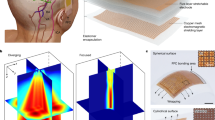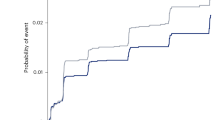Abstract
In patients with severe hypertension, chronic heart failure or a history of stroke, the lower limit of autoregulation of cerebral blood flow (CBF) is shifted to higher levels of blood pressure (BP) than those observed in healthy subjects. The aim of pharmacotherapy for hypertensive patients with an impaired autoregulation of CBF should be to reduce BP while preserving an appropriate CBF. In the present study, 16 hypertensive patients who had had an episode of stroke more than 4 weeks previously were administered the angiotensin II (AT1) receptor antagonist losartan at daily doses of 25–100 mg for 4 weeks. Systolic and diastolic blood pressures were recorded for 24 h using an ambulatory BP monitoring system. CBF in both hemispheres of the cerebrum and cerebellum was quantified using single photon emission tomography with N-isopropyl-p-[123I]iodoamphetamine. At baseline, CBF was 29.7±6.7 ml/min/100 g in the cerebrum and 31.5±7.5 ml/min/100 g in the cerebellum. At the end of treatment, BP was lower, while CBF increased by 7.7% in the cerebrum, and remained at the baseline level in the cerebellum. Thus, CBF was preserved despite the reduction in BP. We consider the use of losartan is advantageous for hypertensive patients with a history of stroke in whom autoregulation of CBF is potentially impaired.
This is a preview of subscription content, access via your institution
Access options
Subscribe to this journal
Receive 12 digital issues and online access to articles
$119.00 per year
only $9.92 per issue
Buy this article
- Purchase on Springer Link
- Instant access to full article PDF
Prices may be subject to local taxes which are calculated during checkout




Similar content being viewed by others
References
Strandgaard S, Olesen J, Skinhoj E, Lassen NA . Autoregulation of brain circulation in severe arterial hypertension. BMJ 1973; 1: 507–510.
Kuriyama Y et al. Report of six cases of hemodynamic TIA and its casual relations among hemodynamic parameters. Jpn J Stroke 1987; 9: 463–468.
Kuriyama Y, Sawada T, Omae T . Antihypertensive drugs and cerebral circulation. In: Omae T, Zanchetti A (ed). How Should Elderly Hypertensive Patients be Treated? Springer: Tokyo, 1989, pp 69–81.
Barry DI et al. Cerebrovascular aspects of converting-enzyme inhibition I: effects of intravenous captopril in spontaneously hypertensive and normotensive rats. J Hypertens 1984; 2: 589–597.
Jarden JO et al. Cerebrovascular aspects of converting-enzyme inhibition II: blood–brain barrier permeability and effect of intracerebroventricular administration of captopril. J Hypertens 1984; 2: 599–604.
Rajagopalan B, Raine AEG, Cooper R, Ledingham JGG . Changes in cerebral blood flow in patients with severe congestive cardiac failure before and after captopril treatment. Am J Med 1984; 76 (5B): 86–90.
Paulson OB et al. Effect of captopril on the cerebral circulation in chronic heart failure. Eur J Clinical Invest 1986; 16: 124–132.
Kuriyama Y, Nakamura M, Sawada T, Omae T . Normalization of cerebral blood flow autoregulation after administration of a converting enzyme inhibitor (enalapril) in old stroke patients with hypertension. High Blood Pressure 1992; 1: 239–244.
Iida H et al. Quantitative mapping of regional cerebral blood flow using iodine-123-IMP and SPECT. J Nucl Med 1994; 35: 2019–2030.
Iida H et al. A multicenter validation of regional cerebral blood flow quantitation using [123I]iodoamphetamine and single photon emission computed tomography. J Cereb Blood Flow Metab 1996; 16: 781–793.
Moriwaki H et al. Iodine-123-iomazenil and iodine-123-iodoamphetamine SPECT in major cerebral artery occlusive disease. J Nucl Med 1998; 39: 1348–1353.
Kretschmann HJ, Weinrich W . Neuroanatomy and Cranial Computed Tomography. Thieme: New York, 1986, pp 70–74.
Nishimura Y, Ito T, Saavedra JM . Angiotensin II AT1 blockade normalizes cerebrovascular autoregulation and reduces cerebral ischemia in spontaneously hypertensive rats. Stroke 2000; 31: 2478–2486.
Chung O, Unger T . Angiotensin II receptor blockade and end-organ protection. Am J Hypertens 1999; 12: 150S–156S.
Horiuchi M, Akishita M, Dzau VJ . Recent progress in angiotensin II type 2 receptor research in the cardiovascular system. Hypertension 1999; 33: 613–621.
Husain A . The chymase–angiotensin system in humans. J Hypertens 1993; 11: 1155–1159.
Takai S, Jin D, Sakaguchi M, Miyazaki M . Chymase-dependent angiotensin II formation in human vascular tissue. Circulation 1999; 100: 654–658.
Dahlöf B et al, for the LIFE Study Group. Cardiovascular morbidity and mortality in the losartan intervention for endpoint reduction in hypertension study (LIFE): a randomized trial against atenolol. Lancet 2002; 359: 995–1003.
Author information
Authors and Affiliations
Corresponding author
Rights and permissions
About this article
Cite this article
Moriwaki, H., Uno, H., Nagakane, Y. et al. Losartan, an angiotensin II (AT1) receptor antagonist, preserves cerebral blood flow in hypertensive patients with a history of stroke. J Hum Hypertens 18, 693–699 (2004). https://doi.org/10.1038/sj.jhh.1001735
Received:
Revised:
Accepted:
Published:
Issue Date:
DOI: https://doi.org/10.1038/sj.jhh.1001735
Keywords
This article is cited by
-
The Renin Angiotensin System as a Therapeutic Target in Traumatic Brain Injury
Neurotherapeutics (2023)
-
Mechanisms and treatment of late-life depression
Translational Psychiatry (2019)
-
Pharmacotherapy of Cardiovascular Autonomic Dysfunction in Parkinson Disease
CNS Drugs (2017)
-
Effects of telmisartan on the cerebral circulation of hypertensive patients with chronic-stage stroke
Hypertension Research (2012)
-
The rationale and design of the antihypertensives and vascular, endothelial, and cognitive function (AVEC) trial in elderly hypertensives with early cognitive impairment: Role of the renin angiotensin system inhibition
BMC Geriatrics (2009)



